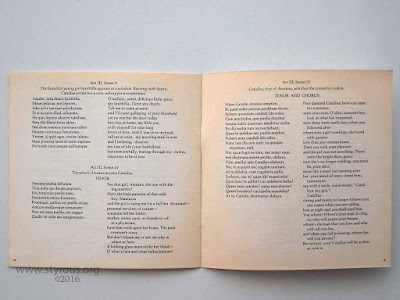
Carl Orff ~
Catulli Carmina
conducted by
Eugene Ormandy
~ ~ ~
I
started the Vinyl LP series because I have a collection of over 20,000 vinyl record albums I am
selling; each blog entry is about an album from my collection. The 101 Reel-to-Reel Tapes series is an extension of that collection. Inquire
for information here.
~ ~ ~
Catulli Carmina (
Ludi Scaenici) is a
cantata by
Carl Orff dating from 1940–1943. The work mostly sets poems of
Catullus to music, with some text by the composer.
Catulli Carmina is part of
Trionfi, the musical
triptych that also includes the
Carmina Burana and
Trionfo di Afrodite. It is scored for a full mixed choir, soprano and tenor soloists, and an entirely percussive orchestra – possibly inspired by
Stravinsky's
Les noces {dead} – consisting of four
pianos,
timpani,
bass drum, 3
tambourines,
triangle,
castanets,
maracas,
suspended and
crash cymbals,
antique cymbal (without specified pitch),
tam-tam,
lithophone,
metallophone, 2
glockenspiels,
wood block,
xylophone, and
tenor xylophone.
 Carl Orff
Carl Orff ~
Catulli Carmina
conducted by
Eugene Ormandy
The
piece is divided into three parts: a prelude with Latin text by Orff,
the central dramatic story using Catullus' poems, and a short postlude
which recalls the music of the prelude.
In the prelude, groups of young women and young men sing to each
other of eternal ("eis aiona" – "forever" – two words of Greek in the
otherwise Latin text) love and devotion, along with quite explicit
statements of the erotic activities they intend with each other. (In the
texts distributed with programs and early recordings, such as the
Turnabout (Vox) one, many lines in the translation are left blank.) A
group of old men interrupts with sarcastic comments and charges the
young people to listen to "the songs of Catullus".
 Carl Orff
Carl Orff ~
Catulli Carmina
conducted by
Eugene Ormandy
The story proper tells of Catullus, a lovesick young man who falls in
love with Lesbia, a woman who does not remain faithful to him. The
tenor and soprano soloists portray Catullus and Lesbia respectively.
This story is based loosely on the factual relationship between Catullus
and Clodia, with a text mostly constructed from the poems of Catullus,
in which he did address Clodia by the pseudonym Lesbia. Catullus wrote
many poems about this relationship and the ones selected for the cantata
take the audience through its several phases.
In this listing, the poems are given the standard numbers.
Subject to occasional textual variants, the poems are as written by
Catullus, except for some interpolations in Latin ('O mea Lesbia' and
the like, and exclamations of approval by the old men) and the curious
extra words in poem 109.

Carl Orff ~
Catulli Carmina
conducted by
Eugene Ormandy
The
piece is divided into three parts: a prelude with Latin text by Orff,
the central dramatic story using Catullus' poems, and a short postlude
which recalls the music of the prelude.
In the prelude, groups of young women and young men sing to each
other of eternal ("eis aiona" – "forever" – two words of Greek in the
otherwise Latin text) love and devotion, along with quite explicit
statements of the erotic activities they intend with each other. (In the
texts distributed with programs and early recordings, such as the
Turnabout (Vox) one, many lines in the translation are left blank.) A
group of old men interrupts with sarcastic comments and charges the
young people to listen to "the songs of Catullus".
Carl Orff ~
Catulli Carmina
conducted by
Eugene Ormandy
The orchestra only plays in the prelude and postlude, whereas in the
Catullus play itself, the soloists are only accompanied by the chorus,
who takes the part of a
Greek choros. The piece experiments with repeated phrases and syncopated rhythms even more so than
Carmina Burana.
Scholars have debated the reason why this is such a lesser-known work
compared to its predecessor for many years. Most of them have decided
that, with the fall of Nazi Germany and the depressed feeling of Europe
in the aftermath of World War II, it simply did not have the opportunity
to be presented to any large audience for a long time. Even now, it is
one of Orff's least performed works.
The story proper tells of Catullus, a lovesick young man who falls in
love with Lesbia, a woman who does not remain faithful to him. The
tenor and soprano soloists portray Catullus and Lesbia respectively.
This story is based loosely on the factual relationship between Catullus
and Clodia, with a text mostly constructed from the poems of Catullus,
in which he did address Clodia by the pseudonym Lesbia. Catullus wrote
many poems about this relationship and the ones selected for the cantata
take the audience through its several phases.
In this listing, the poems are given the standard numbers.
Subject to occasional textual variants, the poems are as written by
Catullus, except for some interpolations in Latin ('O mea Lesbia' and
the like, and exclamations of approval by the old men) and the curious
extra words in poem 109.
Carl Orff ~
Catulli Carmina
conducted by
Eugene Ormandy
Program notes
Tracklist:
Catulli Carmina
A1 I — Praelusio
A2 II — Actus I (Beginning)
B1 II — Actus I (Conclusion)
B2 III — Actus II
B3 IV — Actus III
B4 V — Exodium
Carl Orff - Eugene Ormandy, The Philadelphia Orchestra, The Temple University Choirs, Robert Page
Label: Columbia Masterworks – MQ 930
Format: reel-to-reel 7-1/2 ips tape, Stereo
Country: US
Released: 1967
Genre: Classical
Style: Modern
Notes:
2-eye "360 SOUND" label
Includes four-page libretto
"American Recording Première: The exciting sequel to Carmina Burana"
Net links:
Carl Orff/Eugene Ormandy ~ Catulli Carmina complete on YouTube




































